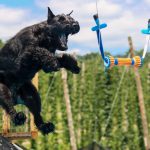
Rare for a reason?
Playing with rare alleles without knowing what they do is foolhardy. We at BetterBred have known that from the beginning as well, because a loosely associated group of breeders and I spent a over decade finding, preserving, evaluating and testing old unusual lines. But here’s a peer reviewed, published paper that says it better than I can:
“Rare variants can be rare due to several reasons: (1) they are linked to genetic disorders and have been (almost) purged from the population, (2) they have drifted from founder individuals and become population-specific, or (3) they are recent mutations. Rare variants can be neutral, beneficial or detrimental and be involved in complex genetic mechanisms that are so far unidentified. Importantly, rare variants may represent a source of variation that is to date not known and may be of some benefit in future breeding.”
Fortunately, BetterBred has methods to address each of these reasons.
First, many remaining rare lines are fairly inbred, which often means obvious disorders have been purged. Any remaining bad recessive or complex variants can be kept at bay by breeding to less related dogs. Dominant trait are more easily identified because they will show up in the dog, which can then not be bred, depending on the severity of the genetic problem. If there are no DNA tests for them, historical records and proper communication among conscientious breeders should offer some information about what the risks can be. Breeders do know.
Second, if rare variants are rare only due to being in a line that is unusual, isolated, or fallen out of favor, we already identify these lines overall with our various measures. We don’t need to know WHICH rare variants they have out of 2.8 billion base pairs, or where on the genome those are, because we know if a dog is significantly different genetically, which will be due to their ancestry being different from the rest of the breed’s. This alone makes them more likely to carry unusual-for-the-population variants.
Third, new mutations are usually recessive, and again dominants show up in the dog. Recessives can be found quickly by inbreeding, which is a sad and unnecessary method for modern breeders, though fast. However, if a new recessive mutation is harmful, it should never become a risk because we now can outbreed more effectively using genomic based estimates of relatedness. If a mutation is beneficial, consistent selection for positive fitness traits will keep it in the gene pool as good breeders have a keen eye for identifying overall fitness. There will always be new mutations in any creature, and Nature has the same strategies for dealing with them. Select for fitness, breed to least related available.
Most importantly, it is, was and ever shall be a BREEDER’S job, not a researcher’s or a DNA test’s, whether they know they are doing it or not, to determine whether rare variants are “neutral, beneficial or detrimental.” Breeders do it in each litter we plan, and with each puppy we pick. We assess each dog and breeding on its merit and select for soundness, health history in pedigrees, proper temperament and existing health testing. We are lucky enough now that we can also add in overall genetic measures for more reliable management of genetic diversity in our breeds. And if we are smart, experienced breeders, we don’t throw out a line if it’s not just like the breed standard – we gradually improve it, which is something conscientious breeders do well.
 Previous Post
Previous Post Next Post
Next Post


